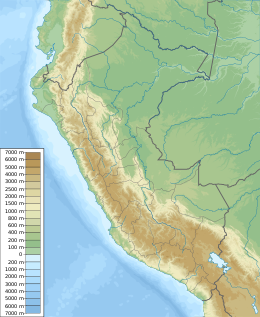This article needs additional citations for verification. (December 2008) |
 | |
| UTC time | 1970-05-31 20:23:29 |
|---|---|
| ISC event | 796163 |
| USGS-ANSS | ComCat |
| Local date | 31 May 1970 |
| Local time | 15:23:29 |
| Duration | ~ 45 seconds[1][2] |
| Magnitude | 7.9 Mw[3][4] |
| Depth | 45 km (28 mi)[3] |
| Epicenter | 9°24′S 78°54′W / 9.4°S 78.9°W[4] |
| Type | Normal |
| Areas affected | Peru |
| Max. intensity | MMI VIII (Severe)[1] |
| Peak acceleration | 0.1 g at Lima[2] |
| Tsunami | .38 m (1 ft 3 in)[5] |
| Casualties | 66,794–70,000 dead[5] 50,000 injured[5] |
The 1970 Ancash earthquake (also known as the Great Peruvian earthquake) occurred on 31 May off the coast of Peru in the Pacific Ocean at 15:23:29 local time. Combined with a resultant landslide, it is the most catastrophic natural disaster in the history of Peru. Due to the large amounts of snow and ice included in the landslide that caused an estimated 66,000-70,000 casualties, it is also considered to be the world's deadliest avalanche.
- ^ a b Plafker, Ericksen & Fernández Concha 1971, p. 545
- ^ a b Cite error: The named reference
Cluffwas invoked but never defined (see the help page). - ^ a b Cite error: The named reference
ISC-GEMwas invoked but never defined (see the help page). - ^ a b Cite error: The named reference
Utsuwas invoked but never defined (see the help page). - ^ a b c Cite error: The named reference
PAGER-CATwas invoked but never defined (see the help page).
